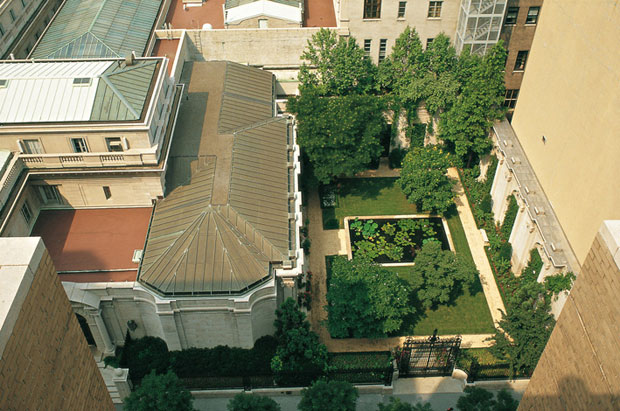‘The art of composing a garden is a question first of selection and then of emphasis.’ - Russell Page
Russell Page is one of the legendary garden designers of the 20th century and perhaps any era. Born in the U.K., his taste for formality and austerity was fostered by his many years in France.
Page designed flower boxes to corporate sculpture gardens and everything in-between. His garden design aesthetic was self-disciplined and though typically large were understated, unfussy and invariably inspiring. Grand but simple, they appeal to the philosopher in each of us. He was brilliant at handling large landscapes.
Russell Page (1906–1985) became known for his excellence in the development of an over-all or master design plan for a site, establishing his reputation by applying the principles of the classical style to the gardens he designed predominantly for the wealthy in Europe and the Americas.
From my personal vantage point, I would classify his design aesthetic as founded in french landscape design. His design aesthetic emphasized the french “control” over the landscape, from use of water as reflecting pools, strong geometry, parterres, statuary, and terraces. For the most part, he did not favor large sculptural landscape designs in the manner of Lancelot Brown or Humphrey Repton. “Most of the gardens that Page designed in England were flower gardens, he set them out in formal patterns that might be called French designs in miniature.”1 Page had very definitive opinions on all things garden related -- he believed Central Park in NYC to be “an abomination.”
As a New York City garden designer, I am particularly interested in his opinions on city gardens. In designing a “town garden” his first concern was to be clear of intent. “Do I want to create a country scene within the limits imposed by the site or is my aim to create an outdoor room open to the sky? Or it may be neither of these and I may find it necessary to make a backdrop, scenery to be seen and judged only through the window, an artificial landscape made to underline and enhance the mood and decoration of an interior.”
Page writes that in approaching this style of garden design, whether “in the town as in the country, a wise garden designer will study his site in silence and consider carefully his clients, their taste, their wishes, their way of life, their likes and dislikes, and absorb all of these factors at least as important as the ground that lies in front of him.”
One of the challenges of an urban or New York garden design is that “trees and buildings and the skyline which are beyond the limit of the garden are ‘borrowed’–brought into the garden which is designed entirely as a foreground.”
A garden designer uses many tools, but inherently he must design the garden by illusion. Initially focusing on “creating a sense of space and volume, then emphasizing a mood. White and pale-blue washed walls have a tendency to open up the space by catching and hoilding the light, whereas dark blue or deep ochre-red tend to absorb light and give a sense of mystery to the space.” A framework overhead (trellis, pergola) can filter light, provide shade, veil unattractive adjacent buildings.
Russell Page makes a point of using deciduous flowering shrubs as they “more gaily herald the arrival of spring on a town garden.”
The “garden architect” (as he called himself) discusses how to plan a garden that draws on the energies of the surrounding landscape. ”My understanding is that every object emanates – sends out vibrations beyond its physical body which are specific to itself. These vibrations vary with the nature of the object, the materials it is made of, its colour, its textures and its form. Any tree has twigs, branches and a trunk – the bark on a twig is other than that of its trunk – the texture of foliage varies through the seasons. So too with a stone – the material and texture of marble differ from those of sandstone or granite, and like the shape and colour of a flower or a fruit these dictate the speed and spread of the emanations of each particular object and thus the interplay between objects. I have experimented endlessly with this idea.”
His thoughts on town gardens in London, are apropos to a brownstone garden design or a brooklyn garden design.
“Garden-making, like gardening itself, concerns the relationship of the human being to his/her natural surroundings. The idiom has changed from place to place and from one period to another, whether we consider the smallest medieval herb garden, a tiny formal pattern set against the curtain wall of a fortifield castle, or the enormous perspectives which LeNotre cut symmetrically through the gentle slopes and forests of the Ile de France.”
If you enjoyed this post please like my Facebook page (Todd Haiman Landscape Design) where you can find other content and news. Thank you!
1- The Gardens of Russell Page, Marina Shinz and Gabrielle van Zuylen
All other quotes attrubuted to Russell Page, “Education of a Garden Gardener.”







